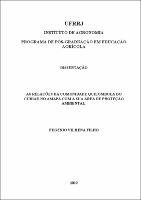Please use this identifier to cite or link to this item:
https://rima.ufrrj.br/jspui/handle/20.500.14407/12692| Tipo do documento: | Dissertação |
| Title: | As relações da comunidade Quilombola do Curiaú no Amapá com a sua área de proteção ambiental. |
| Other Titles: | The Quilombola community relations of Curiaú in Amapá with its environmental protection area. |
| Authors: | Vilhena Filho, Eugenio |
| Orientador(a): | Pereira, Jorge Luiz de Goes |
| Primeiro membro da banca: | Pereira, Jorge Luiz de Goes |
| Segundo membro da banca: | Oliveira, Lia Maria Teixeira de |
| Terceiro membro da banca: | Soares, Ana Maria Dantas |
| Quarto membro da banca: | Pereira, Celso Sánchez |
| Keywords: | Área de proteção ambiental;Representação social;Quilombo;Environmental protection area;Social representation;Quilombo |
| Área(s) do CNPq: | Agronomia Educação |
| Idioma: | por |
| Issue Date: | 27-Aug-2019 |
| Publisher: | Universidade Federal Rural do Rio de Janeiro |
| Sigla da instituição: | UFRRJ |
| Departamento: | Instituto de Agronomia |
| Programa: | Programa de Pós-Graduação em Educação Agrícola |
| Citation: | VILHENA FILHO, Eugenio. As relações da comunidade Quilombola do Curiaú no Amapá com a sua área de proteção ambiental. 2019. 94f. Dissertação (Programa de Pós-Graduação em Educação Agrícola) - Instituto de Agronomia, Universidade Federal Rural do Rio de Janeiro, Seropédica, 2019. |
| Abstract: | A Comunidade Quilombola do Curiaú está localizada dentro da Área de Proteção Ambiental do Rio Curiaú, com sua população de maioria de descendentes de escravos. A presente pesquisa teve como objetivo geral investigar as relações que a comunidade quilombola do Curiaú no Amapá mantém com a sua Área de Proteção Ambiental e como objetivos específicos buscar entender as relações históricas da comunidade quilombola com a constituição da APA do Curiaú, identificar a partir dos saberes tradicionais (representações e práticas), como os remanescentes quilombolas se relacionam com as mudanças em curso na região e com a preservação ambiental. Metodologicamente, a pesquisa se insere no método etnográfico-descritivo. Para tal, utilizou-se como método de levantamento de dados a aplicação de formulários de entrevistas semiestruturados com 09 moradores da comunidade; rodas de conversa e observações de campo, seguindo teorias discursivas e ambientais para a sua análise. Como marco teórico deste estudo, seguiu-se a linha da teoria das representações e práticas sociais ambientais. Os resultados obtidos nos permitem avaliar que os moradores das comunidades quilombolas das áreas estudadas são pessoas bastante comprometidas com o meio ambiente local. Como na opinião dos entrevistados que concordam na proteção do meio natural para que, as próximas gerações possam usufruir dessa terra que não é só de uma pessoa, mas sim, de toda uma comunidade que além de proteger o ecossistema tem de difundir e manter a sua herança cultural. |
| Abstract: | The Quilombola Community of Curiaú is located within the Environmental Protection Area of the Curiaú River, with its population of most descendants of slaves. The present research had as general objective to investigate the relations that the quilombola community of the Curiaú in Amapá maintains with its Area of Environmental Protection and as specific objectives to seek to understand the historical relations of the quilombola community with the constitution of the APA of the Curiaú, to identify from the traditional knowledge (representations and practices), as the remaining quilombola remnants relate to ongoing changes in the region and environmental preservation. Methodologically, the research fits into the ethnographic-descriptive method. To do this, a semi-structured interview form was used as a data collection method with 09 community residents, talk wheels and field observations, following discursive and environmental theories for their analysis. As a theoretical framework of this study, the line of the theory of environmental social representations and practices was followed. The results obtained allow us to evaluate that the inhabitants of the quilombola communities of the studied areas are people very committed to the local environment. As in the opinion of the interviewees, they agree on the protection of the natural environment so that the next generations can enjoy this land that is not only one person, but an entire community that, in addition to protecting the ecosystem, has to spread and maintain the their cultural heritage. |
| URI: | https://rima.ufrrj.br/jspui/handle/20.500.14407/12692 |
| Appears in Collections: | Mestrado em Educação Agrícola |
Se for cadastrado no RIMA, poderá receber informações por email.
Se ainda não tem uma conta, cadastre-se aqui!
Files in This Item:
| File | Description | Size | Format | |
|---|---|---|---|---|
| 2019 - Eugenio Vilhena Filho.pdf | 2019 - Eugenio Vilhena Filho | 11.27 MB | Adobe PDF |  View/Open |
Items in DSpace are protected by copyright, with all rights reserved, unless otherwise indicated.

